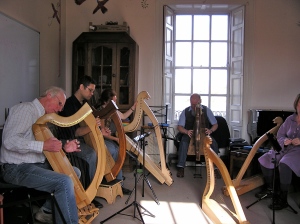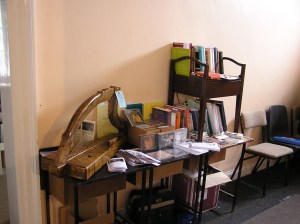Scoil na gCláirseach 2009
In August of 2009 I made my first visit to Scoil na gCláirseach, the Summer School for the Early Irish Harp. This is the 7th annual gathering of historical harpers in Kilkenny, Ireland, and it lived up to my rather high expectations.
I spent about a week in Dublin and traveling around county Meath before Scoil began. The program began on a Saturday, and ended the following Thursday afternoon/evening, with an optional field trip to Dublin on Friday. The attendees were largely from Ireland and the UK, with several Americans, a number of Europeans from the Netherlands, Italy and Poland, and one attendee from Japan.
It is absolutely worthwhile to land among so many experienced players, especially harpers who understand the appeal of historical harps and repertoire.
As a first-time attendee, I received quite a warm welcome, especially from the very gracious Siobhán Armstrong and Simon Chadwick, who are the co-directors.
This year’s Scoil featured three tutors: Siobhán Armstrong, Ann Heymann, and Andrew Lawrence-King, all of whom have international performance experience, but more importantly, all three have a marvelous sense of humor.
A typical day began around 8:30, when several of us would arrive on foot from our B&B nearby, and we’d settle down with a cup of coffee to tune. The most typical sound of the week was the cacophony of tuning, a ritual well-known to any player who’s been at it for a while. Thankfully, I’d brought my Korg and a clip-on pickup. Without the pickup, tuning would have been nearly impossible in a room of 8-12 harpers.
Our group was divided into three subgroups by experience. Each of the groups met in a separate room during the day, and the three tutors circulated among us, teaching a morning or afternoon session. Simon seemed to be able to clone himself, as he slipped from room to room, replacing a string on a new player’s harp, gently reminding a talkative tutor that it was time for the tea break, and talking with everyone in between sessions while fielding questions about the goods at his Early Gaelic Harp Emporium set up in the front hall of the building.
On many occasions the whole group gathered upstairs for one of the tutor concerts, or for lectures or social events. There were the basics, including very worthwhile lectures on the history of the early harps, and their characteristics and features. And then there were the guest lecturers, including Keith Sanger, who co-authored Crann nan Teud, or Tree of Strings, with Alison Kinnaird back in 1992. The book, which I’d read years before, chronicles the history of the harp tradition in Scotland. My favorite presentation was by Prof. Breandán Ó Madagáin on the supernatural functions of music, vocal and instrumental, in the native Irish tradition. He is a Professor Emeritus of the National University of Ireland at Galway, and a specialist on music. He lectured on the function of keening in Irish tradition, and demonstrated the form of a keen by singing in Irish. Now, I’d heard his audio CD and bought the book that accompanied it, but to hear the work live was another matter.
Everyone talks about the food, and I understand why. We were treated all week long to deliciously hand-prepared food at morning and afternoon tea break, and lunch was consistently toothsome, and largely vegetarian. Some of the better conversations of the week occurred in the kitchen over a cup of tea or coffee, and encouraged by some scrumptious treat or other.
In the evenings people gathered in small groups to head off to dinner in Kilkenny, and at times I would walk back to my lodgings to take a break from the intensity of so many hours in the company of others. I shared a room with two other experienced Scoil participants, and several other students were in other rooms in our lodgings. On several nights the group met at a pub in town for a session. Quite a few of the students play other instruments, including Sylvia Crawford, who is a marvelous fiddler, and Jim Johnston, who is a singer, guitarist, and songwriter. Shy by day, Jim had an amazing sparkle in his eye, and a big, strong, joyful voice on each of those pub evenings. Brenda Malloy often brought her big Downhill harp, and often Barbara Karlik would play her clarsach and sing. On one evening Siobhán Armstrong sang a sean nos song, and the noisy pub crowd listened in hushed silence. It was a good evening, and I enjoyed the pear cider and the good company.
Back in lodgings, we’d all breakfast together before walking to classes in the morning. There were days when the fog was clinging to the river Nore as I crossed the bridge and passed the castle on the way to the Kilkenny School of Music, and I had to pinch myself to be certain that I wasn’t dreaming. It was an extraordinary scene, and a delicious week of challenge, learning, and conversation.
Next up: the field trip to Dublin! Coming soon…






Sue, you are being modest. Absolutely the finest and most memorable moment of Scoil 2009 was: “Can we take photos?”